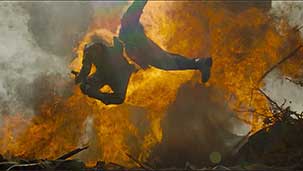If you look up overwrought in the dictionary I’m pretty sure Mel Gibson will reach up from the page and punch you.
There is a scene in Tropic Thunder, where Danny McBride—playing a pyro supervisor like yourself—prematurely unloads the money shot, and tons of napalm obliterate a treeline while helicopters swoop through the frame. You can practically smell the Victory. Unfortunately, while watching Hacksaw Ridge, every time I saw another ton or so of high explosives tear up the now famous Okinawan ridge line, that scene from Tropic Thunder kept popping into my head.
That’s not a good thing.
Hacksaw Ridge feels like certain WWII films from the Sixties—things like Battle for Bloody Beach or Hell Is For Heroes — which were far more concerned with putting bums in seats than achieving anything resembling historical accuracy. I watched a lot of these growing up, never connecting the pictures up on the screen to anything real. Even at a young age I understood that this was a bunch of people playing war rather than trying to create something depicting the actual horrors of armed conflict.
There is never a moment in Hacksaw Ridge where everything: performances, the score, the gore, and the bodycount isn’t screeching towards you at a volume way past 11. It is a film filled with the kind of cornpone archetypes that seem more like parody than actual human beings. There’s the overly muscled Hollywood type (this character made me laugh, and not when intended), the tough asshole who comes around to respect the hero in the end, the conflicted but decent Captain who needs to whip his sad lot of misfit toys into fighting shape and finally there is the protagonist—a Seventh Day Adventist contentious objector who won’t touch a gun, but who will run head first into enemy fire to save people that, until recently, had made beating him bloody a clubhouse sport.
And the thing is this character, Desmond T. Doss, was a real person who actually saved over seventy five men in one night when his unit retreated from the titular Hacksaw Ridge. He stayed and managed to drag dozens of wounded to safety while dodging enemy patrols and the shells of his own ships. That story is so inherently dramatic and compelling that it hardly needs any of the bombast you so ably contributed to.
There is a scene early in Saving Private Ryan when, as Tom Hanks leads his men toward the beach, he is momentarily deafened by a near miss from a mortar shell. The next two or three minutes we witness the carnage being inflicted on his men while the soundtrack is turned down to a whisper. It is a hauntingly effective sequence made all the more so by the creative choices by the director. There is none of that subtlety here. Instead we get scene after scene of Japanese soldiers (so shallowly depicted they felt like cannon fodder from a low-end video game) being torched by flamethrowers, squared jaw white dudes charging pillboxes, and the requisite hero falling on a grenade to save his buddies.
None of this works anymore. After Apocalypse Now and Full Metal Jacket, the aforementioned Saving Private Ryan and any number of films that attempt to portray the true madness of war, Hacksaw Ridge feels like a weak, anachronistic throwback. I didn’t care about any of the characters, so no matter how creatively you managed to burn, blow up, or shred them, it all felt like an empty exercise. This story deserved better.
Sincerely,

Tim
Here's a safe gift for the pyromaniac in your life...
Check out this DC&C Special Tie-in today.







